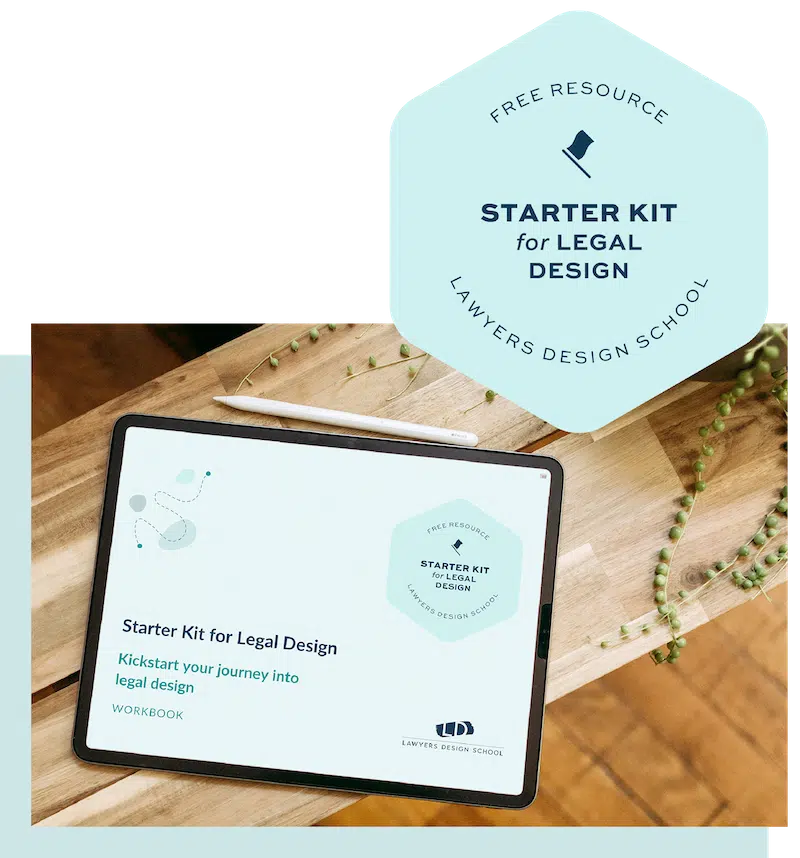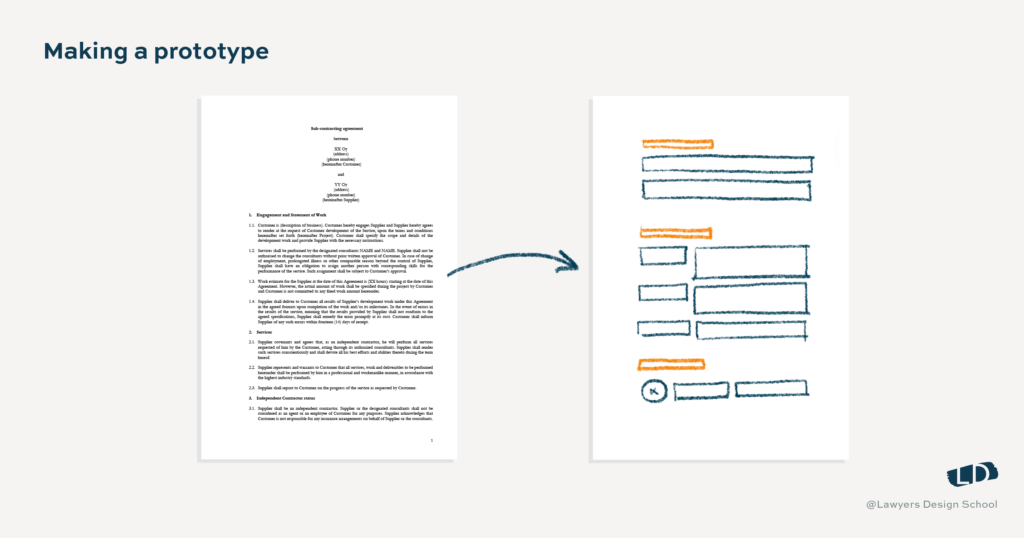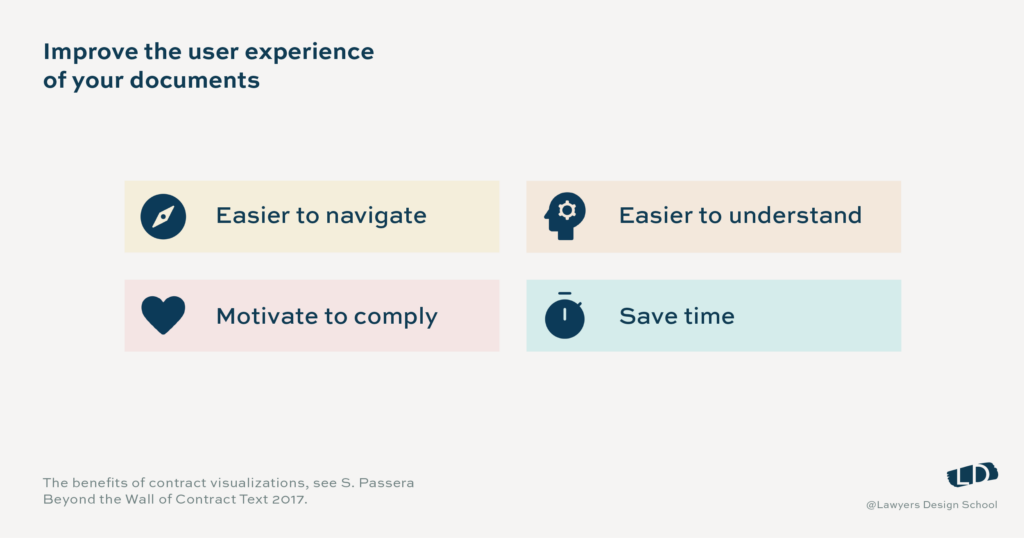What is contract design in law
Contract Design in law is a people-first approach to structuring and presenting legal information. By redesigning contracts, lawyers look beyond the legal substance of a contract and present the substantive information in a way users can understand. Lawyers already know what’s in the contract and what the terms mean. But attorneys need to make sure that other people understand it too. Contract Design is an intentional approach to presenting legal information so that legal documents are empowering, user-friendly and easier to understand.
By applying legal design thinking, lawyers can redesign contracts that their clients are grateful to read, streamline in-house workflows, drive action and reduce the time to sign. To get it right, lawyers must understand the user, show empathy and produce meaningful information users can act upon with certainty.
Redesigning contracts improves client satisfaction
Legal contracts represent a meeting of minds on how a commercial relationship will work. But lawyers make it difficult for clients to understand contracts. Therefore, minds rarely meet because everyone is too busy scratching their heads over what the words mean. It wastes time, damages relationships and gives lawyers a bad reputation.
Contract Design in law means we often:
- change the structure
- change the words
- change the layout
- change the look of the document
- add illustrations and graphics
To ensure the contracts are user-friendly.
But they are only parts of contract redesign. It’s not styling your document and it’s not pretty pictures.
Contract Design is successful when users understand and are empowered by the information – and sign.
Contract Design fails if users are overwhelmed and more confused than when they started – and need another meeting to negotiate.
In this comprehensive guide, the team at Lawyers Design School and Contract Design School are exploring how Contract Design works, the benefits for our users and how you and your legal team can get started. Find out more about whether Contract Design is for you.
If you want to know more about Contract Design, head to Contract Design School where you can learn everything about Contract Design: Simplification, Visualization and how you can serve your clients your way.
Why is contract design important for lawyers
Contracts are for people, not judges.
Traditional legal contracts are lawyer-centric
- Long-form, boring and full of legalese (with the key advice buried in the document)
- Written in small font with very little white space
- Adversarial in approach and written to protect the lawyer in the event of a dispute
- Devoid of headings and other visual elements to make navigating the contract easier
- Written for other lawyers and judges to interpret in court
When I was in law school, we learned how to write laws, not how to write in plain language. Plain language makes contracts easier to read and also allows lawyers to find clauses that aren’t clear or helps them find gaps so they can fix them.
I rarely see contracts in plain language and I’m sure if I asked you off the record, you’d tell me you’ve come across contracts with terms you didn’t understand yourself. Am I right?
Ask your clients about their experiences with your contracts. They might say “TL;DR.”
Is TL: DR the customer experience you want to offer? Our contracts and language can enhance our client experience – and help lawyers keep great clients.
Why are we holding on to this archaic mess?
It’s time for a change.
Clients want legal documents that meet their goals
Legal clients want contracts that get business done and forge strong relationships that are fair for everyone. Clients are frustrated by the complexity, the brain overload and the unnecessary legal jargon. It’s exhausting.
The objectives of Contract Design and traditional contracts are different. Traditional contract drafting means lengthy documents that protect against every potential legal risk. Lawyers think of every scenario that can go wrong and then cover that in the contract language.
Contract Design places equal emphasis on creating balanced and enforceable documents. Which means the legal document is effective in practice. The contract is easy to use and understand and works for all parties involved. Contract Design allows lawyers to consider the bigger picture of the different stakeholders and their relationships and try to develop more balanced contracts.
The adversarial days of lawyers drafting aggressive documents that foisted risk on the other party are over. Clients want lawyers who support them holistically and contracts that support their efforts and get the deal done.
New lawyers expect more
And older lawyers are tired of the old ways. Am I right? Gen Z lawyers are the lawyers coming into practice now. The first generation born in the digital age, their priorities and values differ markedly from other generations. Gen Z wants meaning, diversity and inclusion. Read more about Gen Z and law and its impact on the legal profession.
These emerging lawyers won’t accept traditional practices and will potentially be more vocal in their call for equality and accessibility. My question is, who will run the firms if we don’t embrace new ways of doing things? “Leaving the law” is still the highest-ranking search term on my website.
Contract Design allows lawyers to add meaning to their work and truly help people. It naturally inspires Gen Z because of its modern framework
- human-friendliness
- creativity
- visuality
Will Gen Z lawyers be happy adding fields to precedent contracts day in and day out?
The clever lawyers are already using contract design
If you’re reading this thinking Contract Design is a fad, I encourage you to open your mind to modern law. Many practitioners are leading the way in changing the way lawyers work. Failing to listen now could lead to irrelevance in the future.
Contract Design feels challenging for lawyers. But it’s not. Change-maker lawyers are designing contracts as tools for success instead of tools of destruction.
Lawyers are becoming more human, collaborative and holistic in what they do.
“Many lawyers have realized a world of knowledge exists outside of the legal curriculum. They’re learning new skills, new ways of doing things, and new ideas while integrating all of those together with their legal skills. Integrative lawyers offer the broader perspectives necessary to blend the roles of peacemaker, adviser, coach, and consultant.”
Covid forced lawyers and the system to adapt and change how they practice law and interact with clients. AI advancements like Chat GPT offer solutions for clients and opportunities for lawyers we’re only beginning to explore.
What will the law look like if Chat GPT can generate a user-friendly, easy-to-read contract in 30 seconds? Imagine if our clients could produce the same contracts at home!
Designerly lawyering is here – and Contract Design is part of it. Are you ready?

STARTER KIT FOR LEGAL DESIGN
Free resource
Get this free resource to kickstart your journey into legal design.
Add empathy, simplicity, and creativity to your legal work and elevate customer experience.
The designerly lawyer
Lawyers are leading the change here. And it starts with adopting a designerly mindset – getting creative, embracing collaboration and ideating how lawyers can add value in ways that clients appreciate and understand. It generates trust and can build a healthy, repeat client base for your business.
If you want to learn more about the designerly mindset for lawyers, start with my four-part series.
Here are some examples of ”new law” these lawyers are using – today.
Examples of designerly lawyers in action
Legal technology is transforming access to justice and how lawyers work
Legal technology encompasses much more than contracts, but legal tech is advancing and traditional legal functions are being replaced or augmented by technology. The way lawyers work is evolving and how lawyers work will look very different in five years. And it’s all good news.
“..people don’t want lawyers — they want justice. So, lawyers should look at ways to make technology provide it.
In the contract space, we see contract templates available for purchase online. I was part of a document automation start-up, now called Ment. But it’s not only about downloading a template. Companies like InvestCEE are using legal tech to humanize contracts. You can check out the Lawyers Design School channel on YouTube for various interviews with experts transforming contracts with design.
Proactive and Preventive Law
Helena Haapio specializes in proactive and preventive law and Contract Design is a fundamental piece of this practice. Instead of anticipating disputes and creating contracts to defend them, proactive and preventive law aims to embed legal knowledge into the clients’ strategy and behavior and deliver contracts that focus on balancing risk with reward. Lawyers act as strategic partners in helping their clients achieve their goals – through more than paper.
Read more about how Helena uses sustainable contracts to humanize the law and empower her clients.
Conscious Contracts
Conscious contracting is a values-based approach to contracting where lawyers act as consultants and coaches to work with the users to create a contract based on the users’ shared values. The collaborative approach starts with the reason they’ve chosen to work together, their shared goals and how their shared values will determine how they handle hiccups.
There are no behind-closed-doors discussions. The parties know why they want to work together and they trust each other. These are the foundations of the contract. Just as Contract Design is a mindset and a process, so is conscious contracting.
Visual Law
Visual law aims to replace complicated legal information and present it visually. Visual cues empower and educate your user. Visual design in legal documents makes complex legal topics more accessible and human.
Again, it’s not about making a pretty document. It’s intentional design and presentation so your user relates to the information – and most importantly, understands it. In the world of information overflow, visual cues help clients to navigate legal information and make it more interesting for them.
Some examples
- You can improve how the legal information is presented visually, like using white space, colours, symbols, page layout and typography
- You can turn your words into infographics, flow charts and tables
- You can use new genres like comic contracts or videos
The goal is to present information in a way the users’ brains can consume and understand it most effectively. Plain language writing is a fundamental part of visual law.
You can apply visual law to barristers’ briefs, letters, instructions, emails, petitions, and claims. You can use it to present legal advice by visually illustrating options, outcomes and potential solutions in a flow chart. You can do the same with judgements.
Visual law complements rather than replaces legal writing. See how you can use visual law in your legal work today.
Contract design misconceptions
Contract design is about making contracts pretty
I had some medical tests done a few years ago. The email from the doctor opened with “YOUR RESULTS ARE NEGATIVE.”
I was relieved. But the thing is, the email went straight to the point and then went on to explain the specifics.
Your clients want that too. Tell me the answer and the potential scenarios first and then I can get into the detail (if I want to).
We re-organise and re-write information to help users integrate information quickly, reduce misunderstandings between the parties and facilitate successful commerce.
When lawyers take the time to understand their clients and deliver on their needs, it fosters loyalty.
It’s making contracts better, not prettier to look at.
( And I know I’ll be going back to that Dr.)
We need to design every new contract
Lawyers don’t redesign every new contract. The old contracts from the last century need a re-structure. But once done, it’s about applying the designerly mindset to each scenario and drawing on your library of user-centric documents. Because you understand your client, you can present the information in a way they will absorb and understand.
Law firms can have precedent libraries – just more human-focused and agile ones. Imagine the possibilities with Chat GPT and Open AI.
Simplifying legal contracts affects their validity
Contracts are legal instruments with legal implications and have a long history of interpretation and precedent. This history shapes how lawyers write and present contracts – and we continue to cling to it like a liferaft.
But the thing is, you can still capture the law without the legalese and complicated language.
Lawyers tell me that making contracts simpler and easier to understand will render them invalid. We consider risk and likelihood when we simplify contracts, but simplifying a contract does not make it invalid.
In reality, contracts need to fulfill certain criteria to be enforceable. They vary across countries but in the United States, a contract is enforceable if it has
- Valid offer and acceptance
- Adequate consideration
- Capacity
- Legality
I don’t see “in writing” or “legalese” here anywhere, do you?
No one wants to read a 29-page letter in 10-font Times New Roman that covers every imaginable risk and option. Users want to achieve their outcome, as soon as possible, with the path ahead front and centre.
Contract design means I need to learn graphic design
Nope. As I’ve said, rethinking contracts is a mindset and process. While we aim for a simple and clear presentation of information, there is no need to learn graphic design. Actually, in my opinion, the most pioneering (and most challenging) work is done with simplifying legal language in contracts. Sometimes the best way to serve a client is by using visual elements or a PowerPoint presentation, but everything you need exists inside Microsoft or Google Workspace.
I need to be a designer
You don’t need a designer qualification. The toolkit and process we use in Contract Design embrace a designerly lawyer mindset. We teach you how to think like a designer at Lawyers Design School.
All you need is the willingness to open your mind to new ways of thinking.
Principles of contract design
Remove negative experiences
In her research on Contract Design, the pioneer information designer and researcher Stefania Passera explains how humans bring their prior experiences with contracts (and the law) to their next interaction with a contract. So it’s important when we design contracts intended to be user-friendly, they look and feel different to other contracts. We understand information when it is orderly, with different font sizes, white space, and bullet points and interestingly, we tend to find things more usable when they are presented with a visually appealing aesthetic.
So our options are open, and the solutions are limitless. Every contract has its issues, and our users are different.
Make contracts unignorable
Contrary to what many lawyers think, we don’t have to reinvent the wheel to innovate. We don’t need to come up with new ways to improve contracts from scratch.
There’s a wealth of knowledge in the field of Information Design that can be implemented and adjusted to our legal context.
Rob Waller’s work at The Simplification Centre is ground-breaking. He and his colleagues use data to show the value of clear writing and visual design. Contract users ignore anything that they cannot understand, and they won’t comply with what they don’t understand.
The most important goal is a document designed in a way the user will most easily understand.
Use Information Design
Information Design makes complex information easier to understand. Enhancing comprehension improves user engagement.
It takes a large amount of information and simplifies it through visual representations or graphic depictions. It combines graphic design principles with data analysis and presentation techniques to communicate information effectively.
Applying principles of information design in our contracts is transformative. It removes the guesswork and offers clear principles and rules to explore. It builds a bank of inspiring design examples lawyers can use in the future.
This approach invites you to use and strengthen your visual thinking skills, which may have been dormant for some time. But learning to examine the contract layout and not just its content can make a huge difference. It doesn’t require you to be a graphic or information designer, just a shift in mindset and simple tools put into practice.
Summary of Contract Design Principles
When designing contracts we consider (this is not exhaustive):
- Information Architecture
- Is the contract easy to navigate
- Layered content
- Contract structure
- Is the order of content designed for the user (most important content first)
- Skimmable headings to support strategic reading
- Summaries
- Contract language
- Simplification of long paragraphs and sentences
- Are the words relatable to the user, the clearest word to convey a message
- Layout and visualizations
- Information display
- White space
- Tables and diagrams
- Icons signalling important “must-read sections” and create consistency
- The contract creation process. Could document automation be an option? Is this contract a simple, everyday transactional document requiring minimal or zero input from lawyers? Maybe designing an automated solution is best.
How lawyers can reimagine contracts in their everyday work
1. Define the user
Remember, you are redesigning the document for your user. Like you, they have their struggles, needs, fears and dreams, and your solution should address these issues. Always keep your user front of mind.
For example, your user may have a young family and a business. They’re on the cusp of finalizing a deal that could change their lives significantly. They are worried about time and getting the deal closed quickly. Your user is not “anyone using the document”, but rather the owners of this family business.
Organizations often have multiple stakeholders with varying needs for a single contract. The CEO’s requirements may differ significantly from those of a sales representative. To ensure the contract serves everyone effectively, it’s crucial to clearly define each user and their unique circumstances.
2. Analyze your document – understand the problems with the document
- Gather data, talk to people. Look at and read the document together to find the pain points.
- Document the findings.
- Work the data to get insights. Don’t overlook stories, they bring life to the data.
- A customer journey map or user persona could be useful here.
3. Come up with ideas to improve
- Structure
- Language
- Layout
- Visual presentation
4. Make prototype (early, ugly & often)
- Put your designer hat on
- Work with the concept level first, forget details and finishing touches
- Prototyping is about making it early, ugly and often
- Make your idea tangible, allow testing and feedback from users
- The process is iterative (trial and error), improve as you go
- You are not going for the perfect solution from the start
Example of a prototype:

5. Test
- With real users, even though it feels scary
- Start with your colleague or friend, if talking to an actual client feels too much in the beginning
- “Show and tell” is the most effective way to get feedback
6. Implement and start using
- Make sure you implement the new design and take it into use
- In legal design, we walk the talk
- Remember the iterative process, learn and then improve
Contract Design – The Benefits for Lawyers

- Your contracts are reimagined from the user’s point of view, making the information clearer, easier to navigate, and use.
- People are also able to close the contracts faster and make sure that all contract benefits are realised.
- Ultimately contracts that are well designed improve efficiency and reduce costly risks.
- Lawyers regain their street cred.
- You create your point of difference using contracts as a key-tool in your brand-building.
“By opening our minds to new ways of presenting information, we can make dramatic transformative change.”
Contract Design allows lawyers to thrive
Contract Design aims to create value and improve outcomes for all parties involved. Including you.
Traditional contract drafting is often viewed as a necessary but burdensome task. You may be distanced from the business and the people you work with and serve. You may find yourself sitting in your cubicle endlessly copying and pasting with minor tweaks.
It is not unrealistic to want to enjoy what you do and use your working hours to serve your purpose. Your purpose may not always go hand in hand with your employer’s purpose, but it’s still possible to design your work life to match your values. For many of us, this means working in a more human, creative, and holistic way, which can also be reflected in our contract work.
I want to quote Robert de Rooy here:
“If you have a purpose, if you’re producing a contract or document or policy that people are actually going to enjoy using, that’s a much better way to spend your time creating stuff that people like, or that serves their purpose positively. Much better than creating stuff that people would prefer to chew on cardboard than read.”
Contract Design means innovation for lawyers.
Where to now
The way we present contracts to our users can profoundly affect their experience and outcomes. The days of standard-issue contracts are gone. Using simplified legal language and words your customers understand is more effective. Considered visual presentation of text immediately improves comprehension and accessibility to our users. When we plan a logical structure with visual signposts it helps make our documents clear, easily navigable, empowering and most of all actionable. (Our users will use them. How cool, right?)
If you and your legal team are still using the same, stodgy contract precedents day after day, you’re right to worry about surviving future law and staying relevant.
Want to learn more? Head to Contract Design School and jump on the waitlist.
Reference:
Haapio, H. (2013). Next Generation Contracts: A Paradigm Shift. Lexpert.
Passera, S. (2017). Beyond the wall of contract text: Visualizing contracts to foster understanding and collaboration within and across organizations. Aalto University publication series.
Waller, R. (2011). What makes a good document? The criteria we use. Simplification Centre.

STARTER KIT FOR LEGAL DESIGN
Free resource
Get this free resource to kickstart your journey into legal design.
Add empathy, simplicity, and creativity to your legal work and elevate customer experience.

